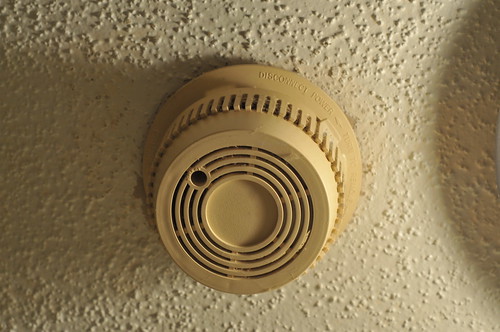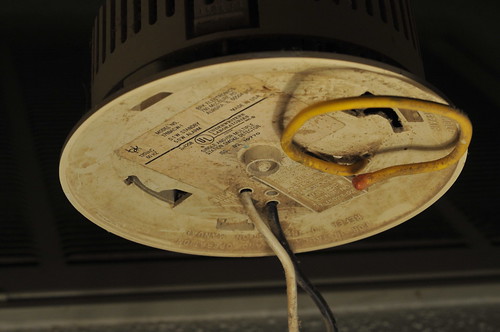|
Richard Noggin posted:I'd like to come up with a better way of providing generator power to my house. My service comes into a 100A service disconnect (a single 100A breaker mounted so the switch flips up and down, instead of left and right) on one wall of the garage. That in turn is wired to the main panel, which is located on the opposite wall. Currently, when we have an extended outage, I flip the service disconnect and the main panel disconnect off, then backfeed the panel. I always make sure that both disconnects are in the off position before I do this. The "standard transfer switch, manual, one each" that I've seen are 200A SPDT switches. The "common" contact goes to your panel, one leg to your service, and one leg to your generator. They're break before make so at no point is the gen connected to the service, so there is a bit of a power blink. They are fairly pricey for humans to buy tho, I think the ones we got in for a supermarket were $600. The ATS for the next building over was the same deal, and only $1000.
|
|
|
|

|
| # ? May 10, 2024 05:07 |
|
Ouch. That's waaaay more than I wanted to spend.
|
|
|
|
If you can put a main breaker on your panel, you could use http://www.interlockkit.com/ Just be sure to use a holddown clip on your backfed breaker.
|
|
|
|
GreenTrench posted:If you can put a main breaker on your panel, you could use I do have a main breaker on the panel, so that would be perfect, thanks!
|
|
|
|
Richard Noggin posted:Ouch. That's waaaay more than I wanted to spend. I asked around. Go to a supply house, you should be able to get a 200-amp MTS for $350 max in a NEMA 3R enclosure. That'd be rainproof outdoor-rated. Should be going for around $200-250 for an indoor surface- or flush-mount.
|
|
|
|
Hey electrical goons, I'm hoping to not burn down my house so I figured I'd stop by. I got a bit of a problem. I need 220 to run my bitchin' new machinery in my shop but the only box available is on the other side of the house behind open beam ceiling. here's a diagram: Click here for the full 772x609 image. I know how to run wires through an attic but I've never had to put them on a roof before. What should I use to shield them? Should I even put them on the roof? Should I hire a real electrician? I don't want to hurt my man pride by having another man's hands all over my house. So help me out a little here if you have any suggestions. Also, I am hurt pretty bad so no crawling. (p.s there is no other 220 in my house to tap off of. It's running my central AC and will explode my home if I tap into it, right?)
|
|
|
|
Walking Spanish posted:
On a roof or in open beams means conduit. Hire an electrician. They might tell you that digging a trench is faster/cheaper, but I don't know about your landscaping. "Tapping into" something to run something else is not good practice. If your bitchin' machinery explodes, then you'd lose your A/C, and vice versa. I don't know where your main panel is, or what "box full of wires" means, really.
|
|
|
|
babyeatingpsychopath posted:On a roof or in open beams means conduit. Hire an electrician. They might tell you that digging a trench is faster/cheaper, but I don't know about your landscaping. I have two breaker boxes. One for the original construction and one for the addition that was put on in the 70's. The "box full of wires" is just a junction box. It was supposed to be a joke I guess V A trench is not an option because of the concrete surrounding most of my home.
|
|
|
|
Walking Spanish posted:I have two breaker boxes. One for the original construction and one for the addition that was put on in the 70's. The "box full of wires" is just a junction box. It was supposed to be a joke I guess V I don't know where you are. Call a real electrician. So much more information is needed about the actual physical layout of the structure, where the breaker box(es) are, what kind of service you need back in your shop, etc. Metal conduit outside. EMT with rain-tight fittings at a minimum. Don't know about your roof, though, so how to secure the conduit thereto is problematic. You may end up with an rear end-ugly EMT run around the face of your house. I look at all the threads in here and I see so much of "the previous owner half-assed this" and I don't want you to be one of those guys. Anything exterior or with conduit is best left to a professional. Amateur pipe work exposed just looks really, really, really crappy. That said, "electrons don't care what the pipe run looks like."
|
|
|
|
I live in a condo on the third floor. At one point, a closet off the kitchen was removed to open up the kitchen and the dining room. When this was done, the main phone line coming into the unit was cut. At the time, I didn't care since I didn't have phone service. Now I am looking into DSL, as well as possibly selling this place later this year. What are my options as far as running a new line? The building has 2 halves and the phone lines come into the building on the opposite half. Running a line on the outside of the building is out of the question.
|
|
|
|
Ok, all you greedy electricians have convinced me to hire a professional. Thanks for your input. Anyone from this thread near the LA area who is looking for some work?
|
|
|
|
Question: One of my outlets is recessed into the wall making it hard to plug things in. I shut off the power and removed the plate and loosened the outlet then put small pieces of wood as shims to push the outlet towards the wall so it sits flush. Wood being an insulator and all, I figured no harm would be done, but maybe I did something that is a no-no. Were the wood shims foolish at all?
|
|
|
|
dwoloz posted:Question: Just put the shims behind the screws? Behind the yoke at the top and bottom? Should be fine.
|
|
|
|
So I drilled a hole through a stud in an exterior wall so that there's less than 1 1/4" from the outer edge of the stud, so I believe it needs a nail plate? Is there anything I can do to avoid ripping open the exterior wall to put a nail plate there? Or can I just drill a new hole?
|
|
|
|
dyne posted:So I drilled a hole through a stud in an exterior wall so that there's less than 1 1/4" from the outer edge of the stud, so I believe it needs a nail plate? Is there anything I can do to avoid ripping open the exterior wall to put a nail plate there? Or can I just drill a new hole? I'd say drill a new hole. Thinking about it, you should be able to bend a nail plate to fit into the hole; it doesn't seem like WHERE the metal is is specified, just that it must exist.
|
|
|
|
Ahh! Out of the blue, some device that looks like an old smoke detector started making a god awful buzz. Two very loud bleeps, maybe one second long with a few seconds in between. I honestly had never noticed it before. It is on the ceiling in the hall way, about one foot away from the "real" smoke detector (which has fresh batteries, tests well, and did not make a peep). My first thought is that it is a smoke detector that is out of batteries, but it seems to be hard wired into the house. There is a dim red LED that is on inside it. The power did not blip or anything when it went off. Is it a smoke detector? Carbon monoxide detector? What else could it be? It is right next to a central air return, if that matters. No one was cooking. The only thing I can think of is that I had to feed the cats some terrible smelling wet cat food as we have ran out of the dry. Surely a warning device for smelly cat food must exist? Is this one?   There are more pictures if you click and they are high resolution if you care. The pictures do not do a good job of conveying the depth of this thing. It sticks out of the ceiling about 2.5 inches. It is much thicker than any smoke detector I have ever seen. I just don't want this thing to go off at night, as I have no idea what it is telling me or how to stop it.
|
|
|
|
There is additional information on the back! Beyond that, what sort of wiring is hooked up to it? Because it's beside another smoke alarm it could be one tied into an alarm system, if so it'll have light gauge wire like phone wire hooked up to it. Also is the other smoke batteries only, or also tied into 120V?
|
|
|
|
I can twist it and take it off, but I am sort of afraid to pull it down too far, as obviously there are live wires up there, and it doesn't want to drop down too far. In other words, I noticed that message too, but I am afraid to investigate it  . .There is no alarm system that we are aware of, no door bell. The smoke detector is batteries only. edit: Smoke detector!  Rotated for your pleasure. Can some one educate me on proper smoke detector etiquette? We have a battery operated detector for both upstairs and for downstairs. Does this wired detector offer us an extra level of protection, or is it just redundant? Why did it go off when the battery detector next to it was silent? Is it too old? I certainly don't mind having a wired one, but as far as I can tell it does not have any sort of button we can press to turn it off if it starts buzzing again, and that is what I am concerned about. pps. what is the yellow wire? I can't seem to figure out exactly how old this thing is, but judging from the design, it cannot be that new. Apparently smoke alarms should be replaced every 10 years, so maybe it is time to replace this one. Is there a recommended brand/type? The BRK site mentions that smoke alarms should not be mounted near humidity (showers), or central air returns, and this thing is mounted within inches of an air return and right outside the door to the bathroom (with shower). Neat. other people fucked around with this message at 02:36 on May 12, 2010 |
|
|
|
I had a hard-wired detector that starting acting up also. It was about 20 years old and I believe they recommend replacing them every 10 years. I replaced it with a new one and haven't had a problem since. I'm guessing the detector is covered in dust and whatnot.
|
|
|
|
Kaluza-Klein posted:pps. what is the yellow wire? The yellow wire is probably to connect to other detectors, so that if one goes off they all go off.
|
|
|
|
I have a problem this thread may be able to help me with. I live on the third floor of a building with five units and share a central wall with a neighbor. My electric meter is inside the building (only accessible to me) and is located immediately above the electrical panel. Recently while cleaning and hanging around near the panel I noticed the meter went from barely moving to spinning quite rapidly as I heard an appliance of some kind start in my neighbor's apartment. I was alone in the apartment, was not using hot water, heating, my dryer or any other significant appliances (laptop plugged in, stove, fridge, microwave plugged in, one set of lights on) and didn't do anything that might have caused the meter to move faster. I'm tempted to think there is something wrong and that one (or more) of the circuits in my neighbor's apartment is tied into my panel (and thus my meter, so I pay for it). It's an older panel (fuses) and not every circuit is clearly marked. I talked with the property manager who has previously lived in my apartment and she suggested that it was probably my water heater operating. I hadn't used hot water in a while and don't think there was any reason for the heater to consume more energy, but then again I do only have my anecdotal evidence to show that something is wrong. My neighbor's appliance sounds like it could be a dryer, but it could also be anything else (he uses power tools rather frequently). Now the property manager has asked that I try to find out if something is really happening by trying to see if the meter moves faster when I hear the noise. This sounds like a lovely way to test for any problem. My other options are to test every fuse to see if I can identify the circuit, then leave anything I can't identify off and wait until my neighbor notices something is amiss, or to wait until I see the meter spinning and shut off the water heater circuit. Is there any other way to do this? What should I look for? The other issue I have is that I have a number of fuses in fuse holders; some have what appears to be a handle to pull them out, but the water heater one in particular isn't like that. It's just a horizontal plastic part with no apparent means by which to pull it out (but it has holes -- do I need to stick something in there to pop it out? I don't want to play around in there without knowing what I'm doing). If it helps, it's a CEB PS-230 fuse holder.
|
|
|
|
Hurricane Jesus posted:I'm tempted to think there is something wrong and that one (or more) of the circuits in my neighbor's apartment is tied into my panel (and thus my meter, so I pay for it).  An easier way would be for your landlord to put an ammeter on your panel and walk around, plugging a high-current appliance (like a coffee pot or space heater) into various receptacles in your neighbor's apartment. If the meter indicates a big increase, you can then check each individual circuit to figure out which one is the guilty circuit. It's his problem to fix, not yours. grover fucked around with this message at 12:46 on May 14, 2010 |
|
|
|
Hurricane Jesus posted:I have a problem this thread may be able to help me with. Next time you hear the appliance, check the meter. If it's spinning fast remove each fuse one by one. If you remove a fuse and the meter stops spinning and the neighbors appliance stops making noise, you have your answer.
|
|
|
|
Both these suggestions are good, however for some of the fuses (fuse holders that don't have a pullout handle) I'm not sure about how to take them out. I think I'll wait until I hear the noise and just shut off the main breaker and see if it stops. The property manager is pretty sure it's the water heater (not impossible, but I tried turning hot water on and I'm pretty sure the meter wasn't going as fast as it was when I heard the noise, etc.) She also says she lived there for three years and never noticed anything, but I don't really consider that evidence. The apartment hardly has any insulation and the heating bills are high (Montreal), so it would be easy to lose the neighbor's consumption in that bill. Of course, they want to avoid having any work done (and want me to come up with some more credible proof before they call an electrician.)
|
|
|
|
Hurricane Jesus posted:I have a problem this thread may be able to help me with. Short of pulling fuses until poo poo stops working, there isn't a hell of a lot you can do to check if it's your load or not.
|
|
|
|
I bought my brother's house that was built in 1956 and I'd like to legally update all it's old 2 prong outlets to 3 prong ones. Five years ago my brother had an electrician swap out the old fusebox for a breaker box, and install a new circuit for a workshop area in the basement. As far as I can tell, all of the original wiring is 14-2 with ground in a metallic-looking woven sheath. I noticed that the ground wire is usually grounded on the outside of the steel boxes, i.e. to one of the screws on knockout clamps; or at any junction all of the ground wires were poked back out their entry holes and twisted together on the outside of the box, then the screw down clamps inside hold the ground wire against the box. Would legally upgrading to 3 prong outlets be as simple as swapping them out?
|
|
|
|
kid sinister posted:I bought my brother's house that was built in 1956 and I'd like to legally update all it's old 2 prong outlets to 3 prong ones. Five years ago my brother had an electrician swap out the old fusebox for a breaker box, and install a new circuit for a workshop area in the basement. As far as I can tell, all of the original wiring is 14-2 with ground in a metallic-looking woven sheath. My parents' house was build in the 50s, too, and their wiring is really degraded. The sheathing is disintegrating and it's #14-2 w/o ground, so I've been steadily upgrading a few outlets every time I visit (ripping out the old wire, and running new #12-2+g back to the panel. You might want to check yours closely, too. grover fucked around with this message at 02:26 on May 15, 2010 |
|
|
|
kid sinister posted:I bought my brother's house that was built in 1956 and I'd like to legally update all it's old 2 prong outlets to 3 prong ones. Five years ago my brother had an electrician swap out the old fusebox for a breaker box, and install a new circuit for a workshop area in the basement. As far as I can tell, all of the original wiring is 14-2 with ground in a metallic-looking woven sheath. Probably. The "poked back out their entry holes and twisted together on the outside of the box" doesn't sound like a UL-listed grounding method. A green ground screw into a specified hole or a green ground clip on the screw is grounding. If it's a metallic box, then it must be grounded. If the box is grounded by all the incoming wires, which ground back at the service, then yes, you can just swap 2-prong with 3-prong. Make sure to test (with the breaker off, preferably) your neutral to ground and make sure it's very close to 0 ohms at every box.
|
|
|
|
I'd like to run a new 6/2 circuit from my panel 30ft to my basement for a tankless water heater. Doable for a non electrician?
|
|
|
|
babyeatingpsychopath posted:Make sure to test (with the breaker off, preferably) your neutral to ground and make sure it's very close to 0 ohms at every box. You mean just a continuity test with a multimeter? Also, again this is an old house and could really use some more outlets in certain rooms. Is there a limit to how many outlets you can put on any one circuit?
|
|
|
|
grover posted:My parents' house was build in the 50s, too, and their wiring is really degraded. The sheathing is disintegrating and it's #14-2 w/o ground, so I've been steadily upgrading a few outlets every time I visit (ripping out the old wire, and running new #12-2+g back to the panel. You might want to check yours closely, too. My house is in a similar situation. Does this mean you're doing a lot of drywall work as well, or is there crawlspace access?
|
|
|
|
stubblyhead posted:My house is in a similar situation. Does this mean you're doing a lot of drywall work as well, or is there crawlspace access?
|
|
|
|
kid sinister posted:You mean just a continuity test with a multimeter? Let's see. 180VA per duplex receptacle. 16A max on a 20A circuit, so that's 16A*120V/180VA= 10.6666 = 10 receptacles per circuit with no other load.
|
|
|
|
babyeatingpsychopath posted:Let's see. 180VA per duplex receptacle. 16A max on a 20A circuit, so that's 16A*120V/180VA= 10.6666 = 10 receptacles per circuit with no other load.
|
|
|
|
grover posted:That's a practical rule of thumb, but there's no legal limit for residential, especially if you're installing extra outlets so there's always a convenient outlet available. You could put 100 outlets on a single 15A residential circuit if you wanted to, and it all meets code. You'll just be pissed when you figure out you have half your house on one circuit and the breaker keeps tripping the second something looks at an outlet funny.
|
|
|
|
Methylethylaldehyde posted:You'll just be pissed when you figure out you have half your house on one circuit and the breaker keeps tripping the second something looks at an outlet funny. grover fucked around with this message at 10:40 on May 16, 2010 |
|
|
|
Methylethylaldehyde posted:You'll just be pissed when you figure out you have half your house on one circuit and the breaker keeps tripping the second something looks at an outlet funny. hey shut up, half the house is on one circuit already. First off, it's a small place, only 5 rooms and a small hallway. I made a circuit map, and the kitchen/dining room lights, east bedroom, hall, bathroom and back porch are all one circuit for a total of 8 light fixtures and 5 outlets. To this circuit I'd like to add 3 outlets. So I guess I'd be better off if I split this up into 2 circuits? edit: I also discovered that all of the ceiling fans were wired with 14-3 with ground, it's just that whoever put those ceiling fans up never hooked them up properly so the light was on the switch and the fan was always hot! It would appear that whoever wired this house originally did a pretty drat good job and the owners in between were idiots. kid sinister fucked around with this message at 18:36 on May 16, 2010 |
|
|
|
kid sinister posted:edit: I also discovered that all of the ceiling fans were wired with 14-3 with ground, it's just that whoever put those ceiling fans up never hooked them up properly so the light was on the switch and the fan was always hot! I That is how they should be wired, as far as I'm aware.
|
|
|
|
Messadiah posted:That is how they should be wired, as far as I'm aware. Unless you have separate switches for the fan and light, in which case the third conductor in the 14-3 gets wired to the fan / fan switch.
|
|
|
|

|
| # ? May 10, 2024 05:07 |
|
Messadiah posted:That is how they should be wired, as far as I'm aware.
|
|
|











 Associate Christ
Associate Christ







